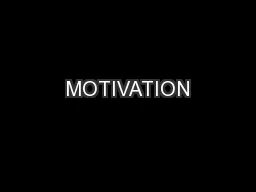

What Motivates a Human Motivation and Emotions Biological Causes of Human Behavior Reflexes Instincts Imprinting Drive Reduction Theory Maslows Hierarchy of Needs Incentive Theory ID: 314023
Download Presentation The PPT/PDF document "MOTIVATION" is the property of its rightful owner. Permission is granted to download and print the materials on this web site for personal, non-commercial use only, and to display it on your personal computer provided you do not modify the materials and that you retain all copyright notices contained in the materials. By downloading content from our website, you accept the terms of this agreement.
Slide1
MOTIVATIONSlide2
What Motivates a Human ?
Motivation and Emotions
Biological Causes of Human Behavior
Reflexes
Instincts
Imprinting
Drive Reduction Theory
Maslow’s Hierarchy of Needs
Incentive Theory
Arousal Theory
Question & FeedbackSlide3Slide4
Emotions
We all have them
Yet most of us can't explain them
Emotions are thought to be the
Causes
and
Reasons
for a large number of human
actions (behavior)
They are thought to be comprised of cognitive, physiological and behavioral componentsSlide5
Biological Causes for Human Behaviour
REFLEXES
A simple unlearned (inherited) act that occurs in response to a specific
stimulus
Human reflexes are classified as
Tendon Reflexes
provide information on the integrity of the central and peripheral nervous system
Biceps reflex
Triceps reflex
Ankle jerk reflex
Blink reflex
Orienting reflex
Primitive Reflexes
displayed by newborn babies but are not seen in adults. Also known as infant or new-born reflex
Babinsky reflex
Grasp reflex Hand-to-mouth reflex Moro reflex, also known as the startle reflex Rooting reflex Step reflex Crawl reflexSlide6
INSTINCTS
Complex inherited patterns of behaviour that are common to all creatures and are associated with specific innate knowledge about how to survive (James, 1890)
Animals are born with innate tendencies pre-programmed at birth with the capacity and often times knowledge of how to survive by spinning webs, building nests, avoiding danger, and reproducing
Humans have same types of innate tendencies when compared to animals. Babies are born with a unique ability to survive; they are born with the ability to cry. Helps in when to feed the baby, know when he needed changing, or when she wanted attention and affection?
Early theorists (James, McDougall) associated enormous tendencies with humans but still not all psychologists believe these tendencies to be instinctsSlide7
IMPRINTING
Animal behaviour develops as a result of the interaction between genetic and environmental influences at an early stage of life. (John Bowlby, 1982)
Imprinting describes an instinctual, unlearned behaviour that is specific to a
species
until an animal has been exposed to the stimulus(
Releaser
),
provided the exposure occurs at right period of animal’s life (
critical period
)
According to Lorenz, ducklings and chicks will follow and become
attached
(socially bonded) to the first moving
object
they encounter (which usually, but not necessarily, is the mother duck or hen)
Imprinting does not occur in the absence of a releaser, or if the releaser is presented too early or too lateSlide8
Drive REDUCTION Theory
According to Hull (1940) organisms possess a hierarchy of needs which are aroused under conditions of stimulation and drive
We act so as to reduce the push exerted by drivesSlide9
MASLOW’s HIERARCHY
OF NEEDS
Maslow
formulated a hierarchy of biogenic and psychogenic
needs
,
in which certain
levels of motives are
specified
Maslow believed
that human motivation
is driven
by a set of
needs
The order of development is fixed:
a certain level must be attained before the next higher one is activated
One must first satisfy basic needs before progressing up the ladder: a starving man shouldn’t be interested in status symbols, friendships or self-fulfilment
If we are interested in what actually motivates us and not what has or will, or might motivate us, then a satisfied need is not a motivatorSlide10
A musician must make music, an artist must paint, a poet must write, if he is to be ultimately happy. What a man can do, he must do (Maslow )
MASLOW’s HIERARCHY OF NEEDS
Self-Actualization
The highest and most difficult level to reach
It refers to the desire for self-fulfillment, namely the tendency for one to become actualized in what one is potentially. This tendency might be phrased as the desire to become more and more what one is, to become everything that one is capable of becoming
If a person has a talent for painting, but they become a doctor, they will be forever frustrated because the need for self-actualization will be hindered
According To Rowan (1998), self-actualization is an ongoing search to develop and to grow and the Maslow’s pyramid of hierarchy of needs is misleading as it suggests that there is an end point to personal growth Slide11
INCENTIVES
Incentive theory holds that certain external stimuli act as incentives, pulling us toward some behaviour
The basic
concept
behind
the incentive theory is goals
intangible
(involve awards or something to give public recognition)
Incentives may be
tangible
(involve feeling good about oneself)
ORSlide12
AROUSAL THEORY
Arousal theory holds that we act so as to bring about an optimal level of arousal (
Donald Hebb [1955])
.
When we are too aroused (e.g. hungry) we act to reduce arousal (e.g. eat).
When we are not aroused enough (e.g. bored), we act to increase arousal (e.g. read a book)
The graph of performance vs arousal is an inverted U: Performance improves with increased arousal up to a point, then it drops off.
Optimum performance on an easy task occurs at a higher level of arousal than on a difficult task.
Ability to do a menial job may actually be improved by having music on, and so forth
Arousal is a term used for a general state of physiological activation. You could think of it as the extent to which your body and mind are "revved up"
Yerkes-Dodson lawSlide13
Why do we do what we do?
Unparalleled Connection between Human and NatureSlide14
Feedback